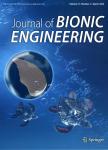Comparison of Algorithms for an Electronic Nose in Identifying Liquors
Comparison of Algorithms for an Electronic Nose in Identifying Liquors作者机构:School of Energy Resources and Mechanical Engineering Northeast Dianli University Jilin 132012 P. R. China School of Chemistry Engineering Northeast Dianli University Jilin 132012 P. R. China School of Electrical Engineering Northeast Dianli University Jilin 132012 P. R. China Aerial Application Technlogy usDA-ARS-SPARC-APMRU Co)lege Station TX 77845 USA
出 版 物:《Journal of Bionic Engineering》 (仿生工程学报(英文版))
年 卷 期:2008年第5卷第3期
页 面:253-257页
核心收录:
学科分类:07[理学] 082403[工学-水声工程] 08[工学] 070206[理学-声学] 0824[工学-船舶与海洋工程] 0702[理学-物理学]
基 金:the Science and Technology Plan Projects Department of Education of Jilin Province P R China (Grant no. 2006026)
主 题:electronic nose liquor algorithm principal component analysis
摘 要:When the electronic nose is used to identify different varieties of distilled liquors, the pattern recognition algorithm is chosen on the basis of the experience, which lacks the guiding principle. In this research, the different brands of distilled spirits were identified using the pattern recognition algorithms (principal component analysis and the artificial neural network). The recognition rates of different algorithms were compared. The recognition rate of the Back Propagation Neural Network (BPNN) is the highest. Owing to the slow convergence speed of the BPNN, it tends easily to get into a local minimum. A chaotic BPNN was tried in order to overcome the disadvantage of the BPNN. The convergence speed of the chaotic BPNN is 75.5 times faster than that of the BPNN.



